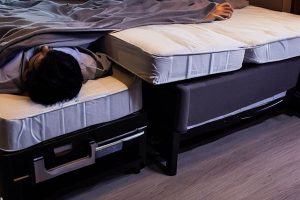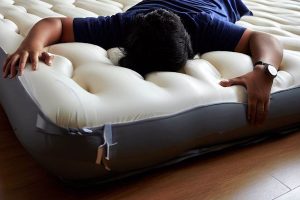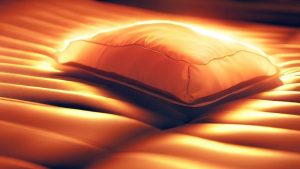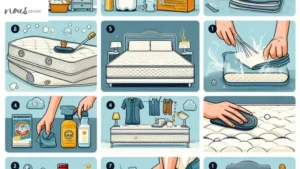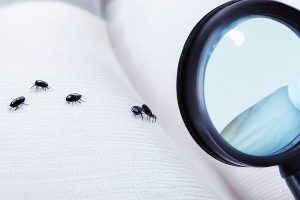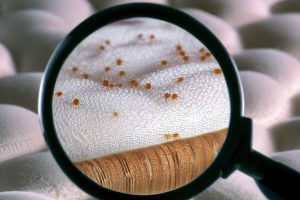Stains on mattresses are like a deep-rooted weed — they may seem easy to get rid of, but they can be a real nuisance. But don’t worry! With the right techniques and supplies, you can remove mattress stains with ease.
In this article, I’m going to guide you through the process of How To Clean Mattress Stains from identifying the type of stain, gathering the necessary cleaning supplies, and applying successful methods for removing pesky stains from your mattress.
So let’s get started with Nousdecor!
Key Takeaways
- Act quickly to remove stains and prevent permanent damage.
- Different types of stains require different cleaning techniques.
- Use specific cleaning supplies such as cold water, mild detergent, vinegar, baking soda, hydrogen peroxide, and dish soap.
- Regularly clean and maintain the mattress to prevent stains and odors.

Identifying the Type of Mattress Stains
As a mattress owner, I’m sure you know how difficult it can be to keep your bed clean and spotless.
Unfortunately, mattresses are prone to all sorts of stains such as blood, urine, sweat, pet messes, and food/drink spills.
In this discussion, we’ll cover the different types of mattress stains and how to effectively clean them.
Blood Stains
Blood stains can be difficult to remove, so it’s important to act quickly. Whether it’s the result of a nosebleed or an accident, blood on your mattress can be the toughest stain to remove.
First, try blotting up as much of the liquid with a clean cloth or paper towel. It may also help to add some cold water and mild detergent if needed.
For foam mattresses, use hydrogen peroxide mixed with cold water and gently dab onto the affected area until the stain fades away. For sweet stains, you’ll need a stronger solution like vinegar and baking soda applied directly onto the spot for best results.
Finally, remember that prevention is key when it comes to avoiding these types of mattress stains in the first place! Taking off your shoes before getting into bed will go a long way towards protecting your mattress from unwanted messes like pee stains.
To move forward in dealing with urine stains….
Urine Stains
Urine stains can be a tricky thing to tackle, so it’s important to act fast. Here are some tips for dealing with urine stains:
- Cat Pee: Start by dabbing the area with cold water and a cloth. Then, make a solution of one teaspoon of dish soap and one cup of cold water. Blot the stain until it is gone, then rinse it off with cold water and dry.
- Washing: If the mattress cover is machine washable, you can remove any remaining stain by washing in cold water on the gentle cycle. Make sure to use an enzyme-based detergent for best results.
- Steam Cleaner: For more stubborn stains, use a steam cleaner or hire professionals to do it for you. This will help get deep into the mattress fibers and remove any lingering odors or residue from laundry detergents or cleaners used previously.
After tackling urine stains, it’s time to move onto sweat stains which require their own special approach.
Sweat Stains
Sweat stains can be stubborn, so it’s important to know how to tackle them quickly and effectively.
To begin, baking soda is a great way to remove sweat odors from mattresses. Sprinkle some on the affected area and let it sit for at least an hour before vacuuming it off. For a deeper clean, steam cleaning or dry-cleaning can also be used.
If your mattress has a removable cover, washing bed bug mattress covers in hot water with liquid dishwashing soap will help get rid of any lingering sweat odors. Remember to allow time for your mattress to fully dry before putting sheets back on!
With these tips in mind, you’ll be able to easily remove sweat stains from your mattress.
Now onto tackling pet stains…
Pet Stains
If you have a pet, chances are you’ve had to deal with their accidents on your mattress. Pet urine or feces can create an unpleasant odor and leave oily stains that can be difficult to remove.
To keep your bed safe from bed bugs, make sure to vacuum the mattress frequently and use a steam cleaner if possible.
To protect against dust mites, use a microfiber cloth dampened with warm soapy water to wipe away any debris.
For oily stains, blot the area with a paper towel before applying an enzyme-based cleaner specifically made for pet stains.
Removing pet messes quickly is key to preventing permanent damage to your mattress and keeping it clean for years to come.
Oftentimes, food or drink spills are also culprits in mattress staining, which we will discuss next.
Food/ Drink Stains
Food and drink stains can be a challenge to remove from mattresses. We’ve moved on from pet stains, so now let’s tackle those pesky food or drink-related spills.
To start, you should use a dishwashing detergent mixed with water and apply it to the stain with a clean cloth or sponge. For tough spots, try blotting with white vinegar and then dabbing with club soda. You can also mix together two teaspoons of dishwashing liquid and one teaspoon of white vinegar before applying it directly to the stain.
Be sure to avoid bed bugs by cleaning your foam mattress regularly using an upholstery attachment in your washer. When tackling food or drink-related stains, always remember to gently agitate the area while trying not to saturate the mattress too much as this could cause further damage.
With patience and some elbow grease, most food/drink related mattress stains can be removed successfully!
Now let’s move on and address how to remove grease stains from mattresses…

Grease Stains
Grease stains can be a nightmare to remove from your mattress, so it’s important to act quickly when they occur. Cleaning products, such as dish soap or laundry detergent, can help in the process.
To remove grease stains using liquid cleaners:
- Pretreat with a small amount of dish soap and water directly on the stain.
- Gently massage the area with a soft cloth or scrub brush.
- Rinse and blot dry with a clean towel.
To use an extermination method:
- Vacuum up any residues left behind from the pretreatment.
- Use baking soda generously to help absorb any remaining grease residue.
- Let sit for several hours before vacuuming up again.
Additionally, prevention is key- use a mattress protector and practice normal wellness habits for both mental and physical health! With these tips in mind, you can prevent future grease stains from occurring and ensure that your mattress stays clean year-round.
And now that we’ve discussed how to tackle those pesky grease stains, let’s move on to dirt/mud stains…
Dirt/ Mud Stains
Dirt and mud stains can be tricky to remove, so it’s important to act fast when they occur.
The first step is to use a vacuum with an upholstery attachment and try to remove as much of the dirt or mud as possible.
If there are still traces of dirt/mud left behind, you may need additional cleaning supplies. These include detergents like dish soap or laundry detergent, a soft-bristled brush, clean cloths, and warm water.
Gently apply the solution with your brush and then blot the stain until it is gone.
When all of the dirt/mud is removed, make sure you dry the area completely before using your mattress again.
Knowing how to clean mattress stains properly will help keep your Dreamcloud mattress trial availability in top condition for years to come.
With these tips in mind, you can easily tackle any dirt/mud stains that occur on your mattress – making sure your Dreamcloud mattress first night sleep experience is always perfect!
Mold/ Mildew Stains
Mold and mildew stains can be tricky to get rid of, so you’ll need to act fast if you spot them. To make sure the job is done right, it’s important to have the right supplies on-hand:
- Cleaning Supplies
- Vacuum cleaner with upholstery attachment
- Cleaning cloths or sponges
- Mild detergent or mattress cleaning solution
- Tools
- Knife for cutting into a mattress (only if necessary, see How to cut a mattress for more info)
- Mattress cleaning with a carpet cleaner (for deep cleaning mattresses designed for better sleep)
- Chemicals: Yellow stains may require stronger chemicals such as bleach or hydrogen peroxide.
By taking these steps and having the right supplies, you’ll be able to tackle mold and mildew stains quickly and efficiently.
Having addressed this issue, we can now move onto the next step, which is…
Cleaning Suplies For Stain Cleaning
You’ll need certain cleaning supplies to effectively remove any mattress stains, so make sure you have them on hand. Below is a table outlining the essential items for stain removal:
| Essential Item | Description | Uses |
|---|---|---|
| Baking Soda | Powdery substance used as a natural cleaner and deodorizer | Absorbing liquid, scrubbing & loosening dirt & grime, neutralizing odors |
| Vinegar | Clear acidic liquid condiment used in cooking & cleaning solutions | Breaking down proteins, dissolving grease, sanitizing surfaces and fabric fibers |
| Hydrogen Peroxide or Rubbing Alcohol | Colorless liquids with antiseptic properties | Disinfecting surfaces and fabrics, removing mold/mildew stains & odors from mattresses |
Having these basic supplies will give you the confidence to tackle any mattress stain. With a little elbow grease and patience your mattress will soon be looking as good as new!
How To Clean Mattress Stains
Removing stains from mattresses can be a daunting task, but it can be achieved with the right knowledge and supplies.
In this discussion, I will cover how to remove different types of stains from mattresses. These include blood, urine, sweat, pet stains, and food or drink stains.
Removing Blood Stains From Mattresses
Blood stains on your mattress can be difficult to remove, but it’s not impossible. Here are the steps to take:
- Cleaning the Stain:
- Blot any excess blood with a paper towel or cloth.
- Apply cold water and mild detergent directly onto the stain.
- Continue blotting until all traces of the blood are gone.
- Treating the Stain:
- Soak up any remaining moisture using a dry cloth or paper towels.
- Apply hydrogen peroxide onto the affected area and let sit for 5 minutes before rinsing with cold water.
- Let air dry completely before replacing bedding on top of it.
- Prevention:
- Use mattress covers that are waterproof and wash them regularly to keep your mattress clean.
- Immediately blot up any accidents as quickly as possible to reduce staining potential.
The next step is to tackle removing urine stains from mattresses – an equally challenging task!

Removing Urine Stains From Mattresses
Now, let’s move on to another stain commonly found on mattresses: urine. You may be wondering how to remove it. Here are a few helpful hints that can take the mystery out of cleaning up this pesky mess.
| Step | Product/Solution | Usage |
|---|---|---|
| 1 | Baking Soda | Sprinkle baking soda liberally over the affected area and allow it to sit for at least 30 minutes before vacuuming it up. This will help absorb some of the moisture and odors associated with urine. |
| 2 | White Vinegar | Mix equal parts white vinegar and water in a spray bottle and spritz over the affected area, then blot dry with paper towels or a clean rag. Repeat if necessary until all traces of the stain are removed. |
| 3 | Enzyme Cleaner | If neither of these methods worked, try using an enzyme-based cleaner specifically designed for pet stains (available at most pet stores). Spray directly onto the stain, then use a damp cloth or sponge to work it into the fabric before rinsing away with cold water. Allow to air-dry completely before remaking your bed. |
Cleaning up urine stains is easy when you know what products to use and how much time is required for each step! Next we’ll look at removing sweat stains from mattresses so they look like new again.
Removing Sweat Stains From Mattresses
Sweat stains can really make a mattress look old and dingy, but luckily there are some simple solutions to help get rid of them.
To remove sweat stains from mattresses, you’ll need:
- Natural cleaning products:
- Baking soda
- White vinegar
- Lemon juice
- Cleaning tools:
- Sponge or cloth
- Vacuum cleaner with brush attachment
- Stain-removing chemicals (optional):
- Oxygen bleach powder
- Enzyme cleaner for fabrics
Mix natural ingredients together to create a paste, then apply it directly on the affected area and let it sit for several hours before scrubbing gently. Use a vacuum cleaner with a brush attachment to thoroughly clean the mattress afterward.
Alternatively, use an appropriate stain-removing chemical such as oxygen bleach powder or enzyme cleaner for fabrics – always making sure to follow the instructions carefully.
With these methods in mind, you’ll be able to remove sweat stains from your mattress quickly and easily.
Now that we’ve discussed ways of removing sweat stains from mattresses, let’s move onto tackling pet stains…
Removing Pet Stains From Mattresses
Pet stains can be tough to remove from mattresses, but there are some methods that’ll help you get rid of them.
| Product | Steps | Results |
|---|---|---|
| Vinegar & Water Solution | Mix 1 part vinegar and 2 parts water in a spray bottle and apply it on the stain. Gently scrub using a soft cloth or brush and let sit for 10 minutes. Blot up the excess liquid with a dry towel or paper towel. Rinse with cold water and repeat if necessary. | Solution breaks down pet urine while removing odor and discoloration. |
| Professional Cleaner | Spray the cleaner onto the stain, scrub gently with a soft cloth or brush, then blot up any excess liquid with a towel or paper towels. Allow it to air-dry completely before using mattress again. | Professional cleaners effectively break down odors while also cleaning the surface of your mattress without damaging delicate fabric fibers. |
These methods can help you tackle those pesky pet stains on your mattress so they don’t become permanent fixtures in your bedroom.
With the right approach, you can restore your mattress’s original beauty quickly and easily, allowing you to move onto other tasks around the house!
Removing Food or Drink Stains From Mattresses
Accidentally spilling food or drink on your bed can be a nightmare, but don’t worry – you can get those unwanted stains out! Here are three methods to remove food and drink stains from mattresses:
- For fresh stains:
- Blot the spill with a clean cloth.
- Mix 2 teaspoons of dishwashing liquid and 1 cup of warm water. Dip a cloth into the solution and apply it to the stain. Rinse with cold water.
- Apply baking soda if there is still a residue after rinsing. Let sit for 10 minutes before vacuuming up the excess powder.
- For dried-in stains:
- Scrape off any solid pieces with a spoon or knife, being careful not to damage the mattress fabric.
- Make a paste using equal parts of baking soda and white vinegar, then rub it onto the stain using an old toothbrush or soft scrub brush. Let rest for 15 minutes before wiping away with a damp cloth.
- Vacuum up any remaining residue once dry.
Once you’ve removed those pesky food or drink stains, it’s time to tackle grease spots on your mattress!
Removing Grease Stains From Mattresses
Removing grease spots from your bed can be tricky, but don’t worry – you can get them out! Start by blotting the stain with a paper towel to absorb as much grease as possible.
Then, sprinkle baking soda on the area and let it sit for an hour. After it’s done soaking up the oil, vacuum up the powder using a soft brush attachment.
If some of the grease remains, dab rubbing alcohol onto a clean cloth and rub over the spot until it lifts away. When you’re finished, use a damp cloth to remove any residue left behind before drying with a hairdryer or fan.
With these steps, you’ll have your mattress looking good as new!
Now onto dirt and mud stains – no problem!

Removing Dirt and Mud Stains From Mattresses
Dirt and mud stains can be a hassle to remove, but don’t worry – you’ve got this!
To start, gather the following supplies:
- Clean cloths
- One damp for cleaning.
- One dry for blotting.
- Vacuum cleaner
- Baking soda
- White vinegar
Begin by vacuuming the area to remove any loose dirt or debris.
Wet the damp cloth with warm water and gently dab at the stain, using circular motions.
Next, sprinkle baking soda over the stained area and let it sit for 10 minutes before vacuuming it up.
To finish, mix equal parts white vinegar and warm water in a bowl and dip your clean cloth into it before blotting at the stain until its gone.
With these steps, you’ll have that mattress good as new!
Removing Mold and Mildew Stains From Mattresses
If you’re dealing with mold or mildew stains, it’s important to take steps to remove them quickly.
Begin by vacuuming the mattress to remove any loose particles from the surface.
Next, mix a solution of one part vinegar and two parts water in a spray bottle.
Spray this solution onto the affected area and let sit for 15 minutes before wiping away with a damp cloth.
If the stain persists, use an enzyme-based cleaner and repeat these steps until it’s removed completely.
Finally, dry your mattress well to prevent further mold or mildew growth.
It’s also crucial to keep your mattress clean on an ongoing basis by using protective covers and regularly changing bedding materials.
Transitioning into other extra cleaning techniques is key for keeping your mattress looking its best!
Extra Mattress Cleaning Techniques to Consider
When it comes to mattress stains, there are a few extra cleaning techniques you should consider:
- Vacuuming:
- Use an upholstery attachment to remove dust and dirt.
- Spot clean with baking soda and vacuum again.
- Treating Odors:
- Sprinkle baking soda over the mattress surface and let sit overnight.
- Vacuum off the excess in the morning.
- Deep Cleaning:
- Create a solution of 1 part dish soap and 2 parts warm water in a spray bottle.
- Spray lightly onto stained areas and scrub gently with a soft brush or cloth.
After these steps, you’re ready to move on to protecting your mattress from future stains!
Protecting Mattresses From Future Stains
To protect your bed from future messes, investing in mattress covers and waterproof pads is key. A mattress cover acts as a protective barrier between you and the mattress, preventing liquid spills and dust mites from getting inside.
Waterproof pads are an added layer of protection that can be placed over any type of mattress to help with absorption.
| Mattress Covers | Waterproof Pads |
|---|---|
| Offers protection against liquids, dust mites and allergens | Absorbs moisture before it reaches the mattress |
| Breathable material allows air flow | Can be washed easily |
These simple steps will go a long way towards keeping your bed clean and fresh for years to come. By taking these proactive measures, you’ll save yourself time-consuming troubleshooting when it comes to cleaning up mattress stains.
Plus, transitioning into the subsequent section about ‘troubleshooting tips for cleaning mattress stains’ will be much easier this way!
Troubleshooting Tips for Cleaning Mattress Stains
Now that you know how to protect your mattress from future stains, let’s look at some tips for cleaning existing ones.
First and foremost, act fast! The longer a stain is left on the mattress, the harder it will be to remove.
Here are some troubleshooting tips:
- Spot Cleaning:
- Gently blot the affected area with a damp cloth or sponge.
- Use a mild detergent and water solution to treat tougher stains.
- Avoid harsh scrubbing as this can damage fabric fibers and leave permanent marks.
- Deodorizing & Sanitizing:
- Create an all-natural deodorizer by sprinkling baking soda over the surface of the mattress and leaving it for several hours before vacuuming off.
- For deep sanitization, use an upholstery cleaner specifically designed for mattresses or hire professionals to do the job properly.
- Removing Odors From Memory Foam Mattresses (see Tools for cutting memory foam):
- Place fresh lemon slices in bowls around your bedroom overnight to neutralize odors naturally.
- Alternatively, use a vacuum cleaner with an upholstery attachment to draw out any odor-causing particles from inside the mattress.

Frequently Asked Questions
Conclusion
Wrapping up this journey of cleaning mattress stains, I’d like to remind you that good habits and knowledge are your best defense against future messes.
Think of your mattress like a garden – with the right care and attention it can be a beautiful place to rest and relax.
Take time to protect it from future stains, stay on top of regular maintenance, and don’t forget to enjoy its plush comfort!

